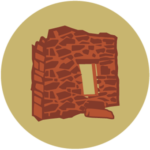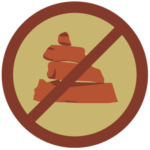Cultural sites are sacred to Indigenous peoples and integral to American history. By treading softly and leaving things as we find them, we show respect for those who came before us and those who will visit after us.

Visit With Respect


View Sites From A Distance
Many Indigenous peoples consider this landscape sacred, and numerous Tribal Elders ask visitors to view sites from a distance. This small act honors Tribal beliefs and protects cultural resources from the destructive effects of visitation, like erosion.

Leave All Artifacts
Artifacts are sacred to modern Indigenous peoples, and scientists can learn valuable lessons about the past when objects stay where they are. Artifacts include pottery pieces, stone tools, rock flakes, and corn cobs. It’s illegal to remove any artifact, including historic trash, from public lands.

Don’t Touch Rock Imagery or Make Your Own
Natural oils on your hands damage these delicate images. Vandalism of petroglyphs and pictographs erases stories of ancient people and destroys the experience for future visitors.

Steer Clear of Walls
Structures are easily damaged. Please refrain from touching, leaning, standing, or climbing on any structures, no matter how solid they look.

Guide Children Through Sites
Archaeological sites are not playgrounds. Teach children to respect these places. Keep a close eye on them, so they don’t get hurt or accidentally damage cultural resources.

Dogs & Archaeology Don’t Mix
To prevent digging and erosion, pets are not allowed in archaeological sites. Please make sure to leash pets and keep them away from the site. Pets are not allowed in some areas, so know beforehand where dogs are permitted.

Camp & Eat Away from Archaeology
Camping, fires, and food can damage archaeological remains and spoil the view for other visitors. Remember to pack out all your waste, including food scraps.

Avoid Building Cairns
Cairns can increase impacts on sensitive sites and are a form of vandalism to the natural world that detracts from the wild beauty of the area. You might not realize you’re making a cairn with an artifact such as a grinding or shrine stone, which is illegal. Leave placement of trail directional signs and cairns to land managers.

Leave Grinding In The Past
Re-grinding in slicks and grooves removes the finish left by those who created them. Please refrain from touching or using grinding slicks.

Historic Artifacts Aren’t Trash
Leave historic artifacts like rusted cans right where they are. They help interpret the past and show who has been there before.

Use Rubber-tipped Poles
A rubber tip prevents your hiking pole from scratching and scarring subtle rock images on the ground.

Pay Your Fees
It may not seem like much, but your small fee helps support important monitoring, enforcement, and amenities like toilets.

Use a Fire Pan
Remember to check when and where fires are allowed. Ground fires leave scars on the landscape and a mess for the next visitor. Bring a fire pan, or at the very least, use existing fire rings. Wait until your ashes are cool to the touch and pack them out.
Pack Out Your Poop
Human and pet waste threatens fragile desert ecosystems and drinking water sources for hikers and wildlife. Poop near cultural sites is disrespectful to Indigenous cultures that hold this landscape sacred. When hiking and camping, please use portable waste bags or a camp toilet. When you just can’t pack it out, do your best by burying your waste 6 inches deep.

Stay On Designated Roads
Use existing roads that are approved for use by land managers. Driving off-road can damage fragile archaeology and ecosystems.

Don’t Bust The Crust
Stay on existing trails and routes to protect the living cryptobiotic soil. Once stepped on, this fragile crust takes years to regrow.

GPS Reveals Too Much
GPS points often lead uneducated visitors to sensitive sites. When posting online about your trip, remove all references to location.

Enjoy Archaeology Without Ropes
This protects delicate archaeology from damage caused by falling rocks and looting. The use of climbing gear like ropes to access archaeological sites is illegal.

Don’t Disturb Fossils or Bones
Leave fossils, dinosaur bones, tracks, and other paleontological remains where you find them so future visitors and scientists can learn from them.

